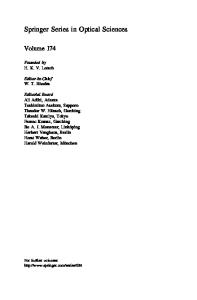Nonlinear acoustics in studies of structural features of materials
- PDF / 4,995,204 Bytes
- 11 Pages / 585 x 783 pts Page_size
- 98 Downloads / 352 Views
entional linear paradigm in acoustical diagnostics Vibro-acoustic and ultrasonic methods have found numerous applications in nondestructive testing (NDT) and materials characterization.1 The sizes and scales of vibro-acoustically probed volumes range over orders of magnitude from fractions of a millimeter in acoustic microscopy to 102–103 m in engineering vibro-acoustic applications, and even greater scales in seismoacoustic sounding. These methods open the possibility to detect and evaluate individual or spatially averaged parameters of such structural heterogeneities as voids (pores), cracks, and delaminations. Their characterization is important since such structural features often strongly weaken the material strength, but yet, before the onset of fracture, they may noticeably affect elastic-wave velocities and absorption, shift resonant frequencies, and cause ultrasound scattering, all of which can be used for nondestructive detection/evaluation of the heterogeneities. Resolution of acoustic methods (defined by the ability to distinguish neighboring structural features) may range from the entire size of samples tested by observing damage-induced changes in their resonance frequencies (such samples may be rather big for low-frequency vibro-acoustic measurements) down to essentially submicrometer scales for acoustic microscopy operating at frequencies of ∼102 MHz. However, even
for waves with much lower frequencies and greater wavelengths, vibro-acoustically detectable boundaries and especially discontinuities (such as cracks and delaminations) may have a thickness much smaller than the wavelength (even submicrometer openings). If their lateral size is not too small compared to the acoustic wavelength, the echo-signals from such thin defects may be easily measurable. However, distinguishing signals from a thin crack and similar-in-size cylindrical/ spherodical holes/cavities may be challenging. The most widely used acoustic NDT method is the pulseecho ultrasonic detection1 of macroscopic cracks and voids. Acoustic microscopy uses the same pulse-echo principle, only downscaled in the probing-wavelength to explore structural features down to the micrometer scale. In some special cases, however, even essentially subwavelength heterogeneities (e.g., gas bubbles in liquids) may produce rather strong scattering and, thus, can be readily detected acoustically. In recent years, this effect has become widely used in medical ultrasound for improving blood-vessel imaging2 by injecting micrometer-sized artificial encapsulated “bubbles” in blood that produce strong scattering of waves at ∼100× greater wavelengths ranging from ∼150–300 µm. The acoustic effects previously mentioned, conventionally exploited in acoustic diagnostics, are linear. They obey the superposition principle—they can be described within the
V.Y. Zaitsev, Institute of Applied Physics, Russian Academy of Sciences, Russia; [email protected] doi:10.1557/mrs.2019.109
350
• VOLUME 44 • MAY 2019 Chalmers • www.mrs.org/bulletin Materials atResearch Downloaded M
Data Loading...











